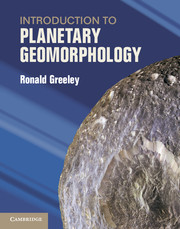Book contents
- Frontmatter
- Contents
- Foreword
- Preface
- Acknowledgments
- Chapter 1 Introduction
- Chapter 2 Planetary geomorphology methods
- Chapter 3 Planetary morphologic processes
- Chapter 4 Earth’s Moon
- Chapter 5 Mercury
- Chapter 6 Venus
- Chapter 7 Mars
- Chapter 8 The Jupiter system
- Chapter 9 The Saturn system
- Chapter 10 The Uranus and Neptune systems
- Chapter 11 Planetary geoscience future
- Appendices
- References
- Further Reading
- Index
Chapter 5 - Mercury
Published online by Cambridge University Press: 05 February 2013
- Frontmatter
- Contents
- Foreword
- Preface
- Acknowledgments
- Chapter 1 Introduction
- Chapter 2 Planetary geomorphology methods
- Chapter 3 Planetary morphologic processes
- Chapter 4 Earth’s Moon
- Chapter 5 Mercury
- Chapter 6 Venus
- Chapter 7 Mars
- Chapter 8 The Jupiter system
- Chapter 9 The Saturn system
- Chapter 10 The Uranus and Neptune systems
- Chapter 11 Planetary geoscience future
- Appendices
- References
- Further Reading
- Index
Summary
Introduction
As a planetary “wanderer,” Mercury probably has been recognized as long as the heavens have been viewed. Although many cultural mythologies refer to this planet, the first recorded mention of Mercury was in 265 B.C. by the Greek Timocharis. With the advent of telescopes and their use in science, careful observations by Giovanni Zupus in 1639 revealed that Mercury goes through phases similar to the Moon. In the 1800s, several well-known planetary observers noted various aspects of Mercury, including supposed surface markings. For example, Giovanni Schiaparelli and Percival Lowell, both of Mars fame, made simple maps of Mercury and named features that they thought could be seen. While most of these features turned out not to exist, some of the names are still used (Fig. 5.1).
Mercury exploration
In some ways, Mercury has been the forgotten planet. Until recently, only NASA’s Mariner 10 spacecraft, flown in the early 1970s, had returned data from this, the closest planet to the Sun. Because of its orbit within the inner Solar System, Mercury is difficult to observe from Earth telescopically, never being more than 28° from the Sun. In fact, many observers are reluctant to train their telescopes in the direction of Mercury for fear that stray light from the Sun would damage the instruments. Nonetheless, some cautious observations were made, which provided key data on the physical properties and astronomical characteristics of the planet. In addition, Earth-based radar observations provided insight into Mercury, including hints of some very large surface features.
- Type
- Chapter
- Information
- Introduction to Planetary Geomorphology , pp. 91 - 105Publisher: Cambridge University PressPrint publication year: 2013



